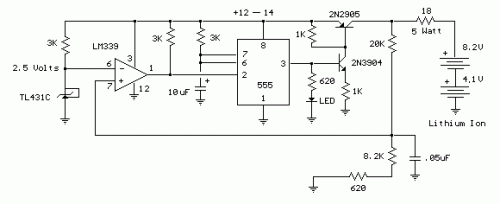- USB Powered Mobile Phone Battery Charger
- NiMh and NiCd Battery Charger Circuit
- NiCd Battery Charger With Reverse Polarity Protection
- Mobile Phone and iPod Battery Charger Circuit
- Mobile Phone Travel Charger Circuit Diagram
- Mobile Phone Battery Charger Circuit
- Mobile Cellphone Battery Charger Circuit
- Low Cost Universal Battery Charger Schematic
- Lithium-Polymer Peak Charger
- In-Car Charger And Switcher Circuit For SLA Battery
- Battery Charger Regulator
- A Friendly Charger Schematic for Mobile Phones
- 12 Volt Car Battery Charger Circuit Schematic
- Versatile Micropower Battery Protector
- Flashing-LED Battery-Status Indicator Circuit
2 Cell Lithium Ion Charger
Description
This circuit was build to charge a couple series Lithium cells (3.6 volts each, 1 Amp Hour capacity) installed in a portable transistor radio.
The charger operates by supplying a short current pulse through a series resistor and then monitoring the battery voltage to determine if another pulse is required. The current can be adjusted by changing the series resistor or adjusting the input voltage. When the battery is low, the current pulses are spaced close together so that a somewhat constant current is present. As the batteries reach full charge, the pulses are spaced farther apart and the full charge condition is indicated by the LED blinking at a slower rate.
A TL431, band gap voltage reference (2.5 volts) is used on pin 6 of the comparator so that the comparator output will switch low, triggering the 555 timer when the voltage at pin 7 is less than 2.5 volts. The 555 output turns on the 2 transistors and the batteries charge for about 30 milliseconds. When the charge pulse ends, the battery voltage is measured and divided down by the combination 20K, 8.2K and 620 ohm resistors so that when the battery voltage reaches 8.2 volts, the input at pin 7 of the comparator will rise slightly above 2.5 volts and the circuit will stop charging.
The circuit could be used to charge other types of batteries such as Ni-Cad, NiMh or lead acid, but the shut-off voltage will need to be adjusted by changing the 8.2K and 620 ohm resistors so that the input to the comparator remains at 2.5 volts when the terminal battery voltage is reached.
For example, to charge a 6 volt lead acid battery to a limit of 7 volts, the current through the 20K resistor will be (7-2.5)/ 20K = 225 microamps. This means the combination of the other 2 resistors (8.2K and 620) must be R=E/I = 2.5/ 225 uA = 11,111 ohms. But this is not a standard value, so you could use a 10K in series with a 1.1K, or some other values that total 11.11K
Be careful not to overcharge the batteries. I would recommend using a large capacitor in place of the battery to test the circuit and verify it shuts off at the correct voltage.
